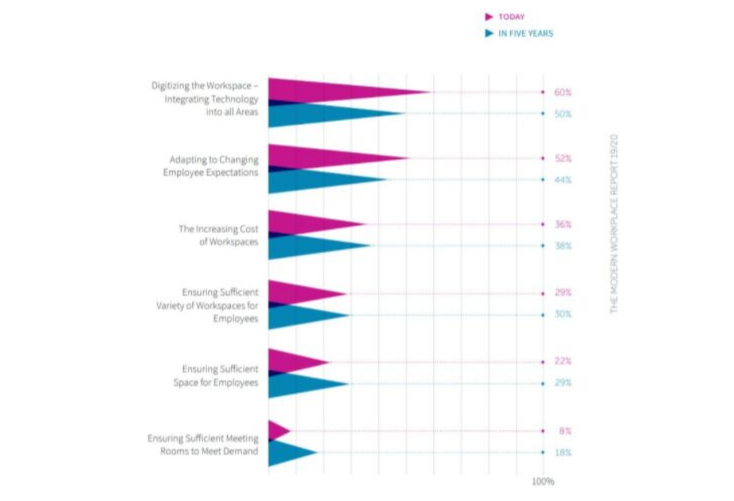- Digital transformation is one of the biggest challenges organizations are facing today, yet many are turning a blind eye.
- The problem is that organizations see digital transformation as ‘an IT thing’ rather than a cultural shift. It also requires ongoing investment.
- However, it’s worth the effort, as a digital workplace can help organizations improve talent attraction and retention, increase productivity and innovation, and reduce costs.
Earlier this year, we examined why a transformational shift to a digital workplace is essential for long-term business success. This need is being driven mostly by an aging workforce, information overload, and the need for speed, with the goal of creating workplaces that run as seamlessly as possible, creating a unique, human-centric experience.
Suggested Reading: “Future of Work: The Rise of the Digital Workplace”
Though companies and business leaders are aware of the importance of digital transformation, it appears that not all of them are truly prepared to go through with the process.
A recent report published by Condeco found that digital transformation and adoption of new technology are the biggest challenges organizations are facing today and will continue to face in the next 5 years, and yet only a fifth of business leaders stated that their organization is “very prepared” for digital transformation.
Digitizing the workspace requires that companies tackle everything “from having the right computers available so that employees can get their jobs done to integrating meeting room booking software, smart speakers, and workspace utilization sensors.”
Digitizing the workspace, at the same time, calls for companies to adopt new and emerging technologies — a challenge companies face in and out of itself. To fully go through a workplace transformation process, organizations will need to fully embrace cloud technology, the Internet of Things (IoT), big data, automation, and — eventually — augmented reality, virtual reality, and biometrics.
Suggested Reading: Giving Apple’s Face ID the Finger: Will Biometrics Ever Work in the Workplace?
In order for the above to happen, significant investment is needed, which is why technology adoption and digital transformation is a challenging undertaking.

Nonetheless, digital transformation and technology adoption are two challenges organizations can no longer push off, especially considering that one of the biggest workplace challenges for organizations is adapting to changing employee expectations — which at the same time can also help organizations tackle the challenge of talent attraction and retention.
The youngest workforce generation, Gen Z, is digitally native; they were born and raised during the age of digital technology. In order for them to be their most productive and efficient, they need to have access to the right tools and resources. This can be achieved by digitizing the workspace.
Though the benefits and advantages of digital transformation are clear — increased productivity and innovation, and reduced costs — why is it that digital transformation efforts haven’t truly materialized?
Some experts argue that it’s because organizations fail to see digital transformation as more than just ‘an IT thing’. Digital transformation beyond embracing new technologies, is about a cultural shift as employees will need to change their behaviors and job routines.
According to a TechRepublic Special Report, “Special Report Digital Transformation: a CXO’s Guide”, digital transformation has become a priority for most organizations, however they fail because they are “glazing over the need to first transform their corporate culture and create new operating models.”
More than that, organizations need to remember that digital transformation is not the destination itself, but rather a means to an end: to deliver a seamless experience, to drive productivity and innovation, to have a more engaged workforce, etc.
According to the special report, the top 8 obstacles companies need to overcome to successfully undergo a digital transformation are:
- Organizational change
- Security: mainly cybersecurity issues
- Legacy systems: just because something has worked in the past doesn’t mean it will work in the future. It’s time to let go of “that’s how we’ve always done things” mentality
- Lack of clarity: digital transformation can mean many things; it’s a broad concept and it’s important to be able to define what it means for your organization
- The “digital iceberg”: organizations and executives need to have a holistic vision of how digital transformation will impact all areas of the business
- Lack of digital literacy
- Understanding consumer demand
- Participation with digital giants: will your services/products be able to integrate with technology giants?


 Dr. Gleb Tsipursky – The Office Whisperer
Dr. Gleb Tsipursky – The Office Whisperer Nirit Cohen – WorkFutures
Nirit Cohen – WorkFutures Angela Howard – Culture Expert
Angela Howard – Culture Expert Drew Jones – Design & Innovation
Drew Jones – Design & Innovation Jonathan Price – CRE & Flex Expert
Jonathan Price – CRE & Flex Expert











